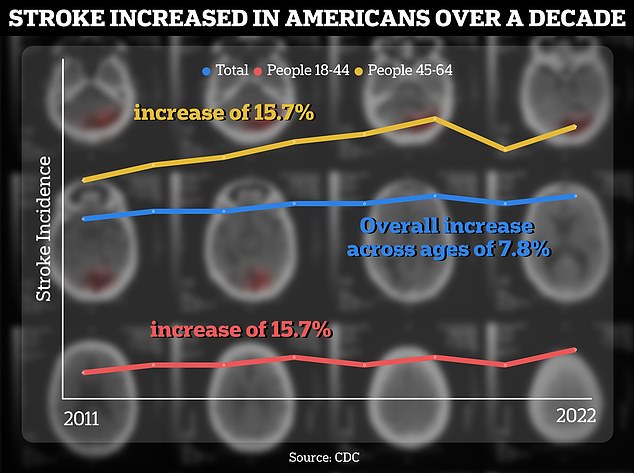Stroke cases in people under age 45 have increased nearly fifteen percent since 2011, according to a new CDC report.
The increase is nearly double that seen in Americans of all ages, which is 7.8 percent, making stroke the fifth leading cause of death in the United States.
The agency observes a simultaneous increase nationwide in those suffering from known risk factors for this deadly disease, such as obesity, high blood pressure and drug addiction.
The findings come amid an alarming rise in cancers among young Americans, which is baffling doctors.
Cases of the disease in those under 50 have skyrocketed by a third in the last 20 years, studies show.
Strokes are a disease that occurs when blood flow to the brain is interrupted, causing inflammation and death of brain tissue. If left untreated, it can lead to death and serious disability.

The CDC report found that strokes have increased in people ages 18 to 64 by about 15 percent when comparing stroke cases from 2011-2013 to stroke cases from 2020-2022.
This is not the first report to find an increase in strokes among young people. A 2023 report of the American Heart Association (AHA) found that the rate of stroke in people under 49 years of age has increased steadily over the past 30 years.
The AHA could not identify a cause for this phenomenon, but said it is likely due to the fact that young people have been subject to greater stress, a more sedentary lifestyle and greater drug use than previous generations.
Conditions that contribute to stroke, such as obesity, high cholesterol and diabetes, are more common today among younger people than ever before, according to the report.
‘The good news is that these are modifiable risk factors. “No one is destined to have a stroke,” said Dr. Christopher David Anderson, a neurologist at Mass General Brigham, in response to the AHA study.
He added: “Treating other risk factors and taking charge of your health is an effective strategy and can prevent the risk of having a stroke from taking hold.”
The CDC is working to address this worrying rise in the condition, which currently costs taxpayers an estimated $56.2 billion annually.
Conditions such as obesity and blood pressure can increase the risk of stroke because they affect the way blood moves through the body.
A stroke occurs when blood flow to the brain stops, either due to a blood clot or a burst blood vessel.
Loss of blood flow to the brain can cause brain cells to begin to die.
If the brain is deprived of oxygenated blood for too long, massive sections of this vital organ can be lost, which can lead to death.
You can survive a stroke and live with damaged brain tissue if doctors treat you early. But if you survive, you may have problems with a wide range of bodily functions, from eating to walking, talking and thinking.
This debilitating disease affected more than 795,000 Americans in 2021. That’s about one stroke every 40 seconds.
Therefore, it is not surprising that the CDC has been tasked with monitoring this deadly disease.
The CDC reached its conclusions using data from its annual Behavioral Risk Factor Surveillance System (BRFSS). The BRFSS surveys Americans annually about a variety of health conditions and daily habits, including stroke.
When comparing the 1,419,351 people surveyed between 2011 and 2013 with the 1,220,972 people surveyed between 2020 and 2022, they found that 7.8 percent more people suffered a stroke.
Among people ages 18 to 44, there were 14.7 percent more strokes than during a two-year period in the early 2010s. Among people ages 45 to 64 there were also 15.7 percent more strokes than during a two-year period in the early 2010s. hundred more stroke cases.
This is a particularly discouraging trend because between 2006 and 2010, stroke cases had actually decreased, declining by about 2.6 percent.
The report also found that people who did not graduate from high school had the largest increase in stroke cases, with an increase of 18.2 percent.
Additionally, blacks, Native Americans and non-Hispanic Native Hawaiians or Pacific Islanders were more likely to have a stroke than whites, the report found.
‘Health conditions that cause strokes and strokes themselves are more common in traditionally disenfranchised populations. “We’re seeing even higher rates in African American, Hispanic American, and East Asian populations,” Dr. Anderson said.
The agency attributed these differences to the fact that minorities and people with less education tend to have lower incomes and worse access to hospitals than whites with advanced degrees.
In response to these findings, the agency underscored a renewed national focus on public health programs to raise awareness about stroke.
According to the CDC, stroke education is one of the key ways to interrupt some of the most debilitating parts of the disease.
This is because if you suffer an early stroke, there are a wide range of treatment options that doctors can provide to save your life and prevent you from becoming severely disabled.
“Advancing focused, evidence-based practices and programs for stroke awareness, prevention, and treatment is essential to improving the nation’s cerebrovascular health,” the new CDC report says.
This is evidenced by the fact that although stroke cases have increased, the number of Americans dying from them has decreased, according to Dr. Ananth’s 2023 study.

